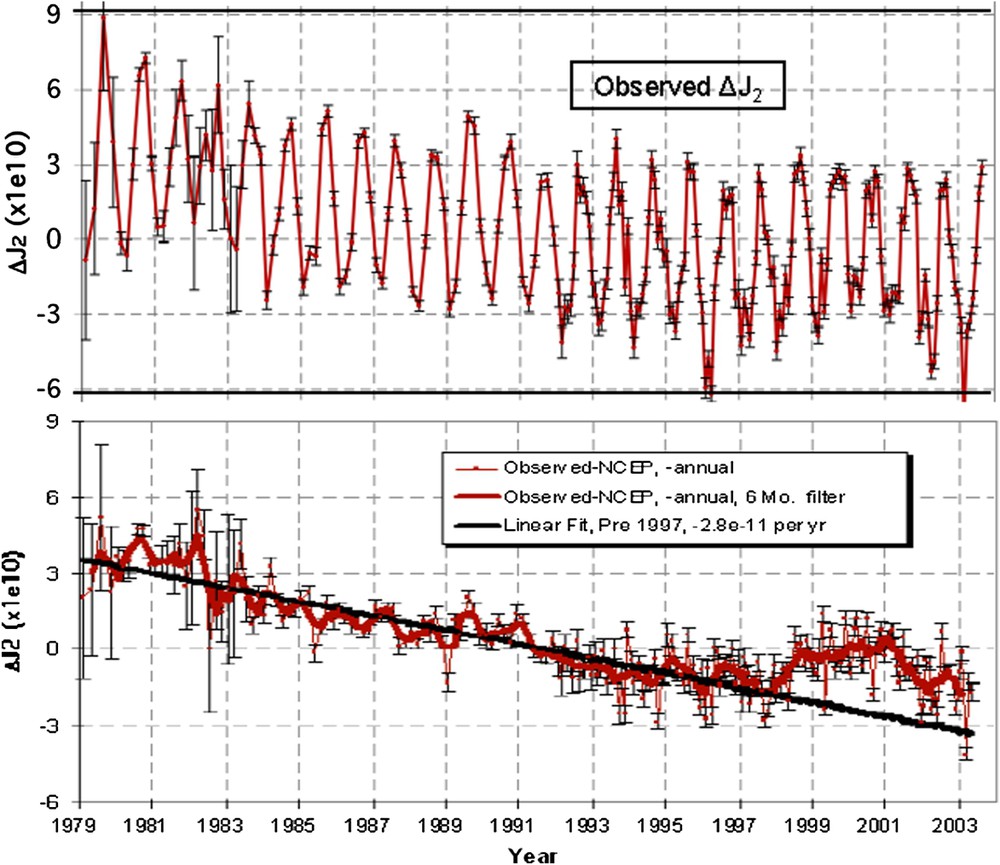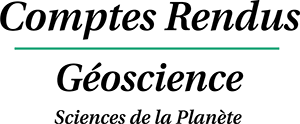1 Introduction
The rotating Earth is oblate, that is, it is slightly ‘flat’ in the North Pole–South Pole direction, compared to the slightly ‘bulging’ Equator. This is the result of the hydrostatic balance between the dominant gravitational force, which wants to pull the Earth into a spherically symmetric configuration, and the centrifugal force due to Earth's rotation, which wants to expel mass away from the rotating axis but in the end only manages to modify the Earth into an slightly oblate body.
Quantitatively, this oblateness is about 1 part in 300, which is very close (but see below) the ratio of the centrifugal force on the equator to the gravitational force. This is by far the Earth's largest deviation from a spherically symmetric body. There are certain thermodynamic, but secondary, processes that cause departures from the rotational-hydrostatic equilibrium. Sustained by the internal heat engine and manifested as external gravity anomalies reflecting lateral heterogeneity of internal mass distribution, these deviations are in general no more than parts per million in relative terms.
Yet all these deviations are not static or constant; they change with time. The rotation of the Earth is itself changing over geological time, and the aforementioned mass heterogeneities also vary on timescales upwards from millions of years. On more human timescales, there operates a myriad of dynamic processes that involve mass redistribution in or on the Earth, from tides to atmosphere–ocean circulations, to internal phenomena like earthquakes, post-glacial rebound and core flows. For the Earth, these changes are typically on the order of parts per billion at the largest [9,24]. The present article is a story about the oblateness in particular and how and why it changes with time, where we examine the geophysical implications.
2 The Earth's oblateness parameters and their inter-relationships
As long as the Earth is a 3-D body, we shall use the word oblateness to describe its off-spherical shape. Traditionally, the term ‘flatness’, or ‘ellipticity’, has been used; these names are imprecise because the Earth, of course, is not ‘flat’, and it is a 2-D geometric object only when we try to draw it on paper.
There are several parameters in use to describe the oblateness; each one has its significance depending on the application in question. For simplicity let's for the moment assume the Earth is axially symmetric, or a body of revolution and so essentially a 2-D body, which is a good approximation.
By equating the general expression of the spherical harmonic expansion of the external gravitational potential field V with that of the mass distribution of a body, one concludes that the spherical harmonic coefficients, or Stokes coefficients, of V are simply normalized multi-poles of the density function of the body [4,5]. When specialized, the degree-2 Stokes coefficients are related to the body's inertia tensor elements through a set of equations known as generalized MacCullagh's formulas. In particular, the degree-2 zonal (order 0) Stokes coefficient is given by:
| (1) |
We can express
| (2) |
The ‘geopotential’ field is V, modified by the centrifugal potential, i.e.
| (3) |
Two more concepts of oblateness can be defined at this point: suppose the Earth is under rotational-thermo-hydrostatic equilibrium. A hypothetical hydrostatic geoid oblateness
| (4) |
Now let us examine the numerical values. m is known to be
Are these matchings in values just fortuitous? From dynamical considerations, one can rightly ‘guess’ that all parameters should be on the order of m, which they indeed are. However, upon closer examination as follows, they do not necessarily have to have such similar values, so in a sense the latter is fortuitous.
For a reasonable Earth configuration, we should have
The interesting, but certainly not out of the ordinary, fact is that, knowing
Based on the PREM Earth model (Preliminary Reference Earth Model [15]) derived from seismological data, the Earth should have an estimated hydrostatic
3 Comparative planetology
For a contrast, let us compare the Earth with the giant planet Jupiter. Jupiter has a faster rotation and a much larger mass, and hence larger radius and gravity. Its
In another extreme example, let us consider a non-rotating, uniform-density body not under hydrostatic equilibrium (hence the shape sustained by its internal material strength), such as an asteroid. Then there exists an analytical, but complex, relationship between the spherical harmonic coefficients of gravity and geometrical shape [7]. For the present discussion, let us further assume a special case where the body is a slightly oblate spheroid. Then, letting
4 Consequences of oblateness
We live in the Earth's gravity field, controlled by the dominant monopole term
A corollary of the above, but on a less dramatic scale, the Earth's dynamic oblateness under the tidal torques exerted by the Moon and Sun gives rise to the astronomical precession of the Earth's rotation axis in space, and hence is the deciding factor for the precessional period. That in fact is how the dynamic oblateness H is determined. On the same token, H acts as the restoring factor that prescribes the free wobble, known as the Chandler wobble, of the Earth's polar motion. The period of the Chandler wobble would be
As stated, the geometrical shape of the Earth largely conforms to the oblate geoid. Therefore, the mean equatorial radius and the mean polar radius of the geoid differ by as much as
As such, the oblateness also affects various geophysical quantities. For example, in the space geodesy enterprise using near-Earth satellites, the oblateness term resides in all Earth surface geometry that locates the geodetic observatories and altimetric targets. Similarly, the oblateness prevails in the external gravity field that significantly affects the satellite orbits from which geodetic measurements are made. On the Earth surface, together with the centrifugal force field, the oblateness gives the surface gravity a slight latitudinal dependence which is actually the largest term in the surface gravity anomaly on the global scale. In another example, the Earth's elastic free oscillation modes (often excited by large earthquakes) see splitting in their otherwise degenerate characteristic periods due to Earth's oblateness and rotation, completely analogous in the atomic world to the Stark splitting and Zeeman splitting, respectively, as such splitting is determined by the symmetry properties common to different dynamic systems [2].
5 Historical Notes
Sir Isaac Newton, based on his law of gravitation and force laws, was the first to realize that the Earth under rotational equilibrium should possess a non-vanishing oblateness. The value of
Then came the space age, ushered in by the launch of USSR's Sputnik I spacecraft in October 1957. A month later Sputnik II was launched, and within a few weeks, by monitoring the nodal precession of its orbit in space, our knowledge of
Today, after nearly half a century of precise orbit determination of dozens of geodesy-quality satellite orbits around the Earth, the Earth's global gravity field has been solved to harmonic degrees as high as 120, among which the average
Since the 1980s, thanks to the advent of the technique of satellite laser ranging [1], tiny temporal variations around the average value of
6 How and why does Earth's
Mass transports in the atmosphere–hydrosphere–cryosphere–solid Earth–core system (the ‘Earth system’) occur on all temporal and spatial scales for a host of geophysical and climatic reasons [9,24]. According to Newton's gravitational law, such mass transport will cause the gravity field to change with time, producing time-variable gravity signals.
Increasingly refined models for the Earth's static gravity field in terms of spherical harmonic components have been determined by means of decades of precise orbit tracking data of many geodetic satellites. On top of that, low-degree components of Earth's time-variable gravity have been clearly observed by the space geodetic technique of satellite laser ranging (SLR) [1]. Although tiny in relative terms (no more than 1 part per billion), these variations signify global-scale mass redistribution in the Earth system.
In particular, the lowest-degree zonal harmonic is Earth's oblateness coefficient
Such was the case until around the turn of the century beginning in 1998, when the SLR data began to reveal that Earth's

(a) Time series of the SLR-observed, non-tidal
(a) Variations temporelles de
A number of possible causes for the 1998 anomaly was speculated by Cox and Chao [12], including oceanic water mass redistribution, melting of polar ice sheets and high-latitude glaciers, global sea level rise, and material flow in the fluid core. Dickey et al. [14] emphasized and demonstrated the importance of the melting of high-latitude glaciers. Chao et al. [10] report an oceanographic event that took place in the extratropic North + South Pacific basins that was found to match remarkably well with the time evolution of the
The difficulty in identifying the definite cause(s) in the above w.r.t.
7 Relationship between Earth's rotation and
As stated, the Earth's oblateness arises from its rotation; the rotational-hydrostatic relationship, to first order, is given in Eq. (4), where the oblateness is proportional to m, which is in turn proportional to
| (5) |
For example, the Earth's secular spin-down due to the tidal braking would lead to a secular ‘rounding’ of the Earth (barring possible temporal retardation under viscosity), thus decreasing
On the other hand, any change in
| (6) |
8 Epilogue
Although numerically small, the oblateness is a fundamental property of the Earth under stable rotation. Its existence and cause, its dynamical and geometrical consequences, its values and departures from idealized models, and its temporal evolution due to mass transports in the Earth system are all fascinating topics in geophysics, which reveal insights towards the understanding of the structure and dynamical behavior of the Earth. The measurement and monitoring of the Earth's oblateness have been a triumph as well as a scientific target of the modern space geodesy. As one sees deeper and finer into the Earth's oblateness, there is little doubt that the Earth will surprise and further fascinate us with a continuing story unfolding with time.
Acknowledgement
This paper is completed under the support of the NASA Solid Earth program. I am grateful to Christopher Cox for providing Fig. 1.


